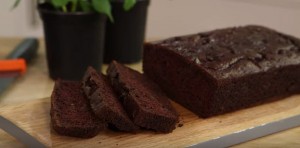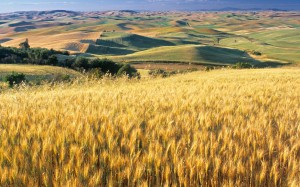Gluten is a general name for the proteins found in wheat, rye, barley and triticale. Gluten helps foods maintain their shape, acting as a glue that holds food together. Gluten sensitivities and gluten intolerance are on the rise, making gluten a very popular topic.
gluten
Chocolate courgette bread recipe – perfect for anyone with diabetes or on the Paleo diet
Nutritionist and chef Christine Bailey shows us just how quick and easy this bake can be. It’s dairy and gluten free and thanks to the zero calorie stevia sweetener, it won’t affect your blood glucose levels- perfect if you’re catering for any diabetics or if you are on a paleo diet. Not only is it packed with flavour, it’s also filled with goodness to give you a natural protein energy boost. And may help promote weight loss.
Your ingredients for this recipe are:
1 medium courgette finely grated (150g)
3 eggs
150g cashew nut butter
30g Truvia calorie free sweetener
25g cocoa powder
30g coconut flour
1tbsp vanilla extract
1tsp cinnamon
1tsp baking powder
½ teaspoon bicarbonate of soda
Pinch of salt
60g sugar free chocolate chips (dairy free if needed)
Just been diagnosed with Celiac disease? Here’s what you need to know!
As you may know last month (May) was Celiac Awareness Month. To help promote this event we published a FAQ based upon an interview with Dr Chris Steele. Steele is both a doctor and a person who lives with Celiac disease.
As part of our preparations for this interview we asked a patient who has been diagnosed with gluten
intolerance and probable Celiac what were the first questions he wanted to know the answers to as soon as he was diagnosed. And we are now delighted to share the results of this interview with you today!It might be worth mentioning that in Dr Steele’s native UK the condition is spelt Coeliac rather than Celiac. This might explain some of the idiosyncratic spelling in this follow up.
Also you might find this introduction to Celiac disease of use and interest.
Patient Talk: If we can just talk a bit about how this might affect any who has coeliac disease or gluten intolerance, what would happen if someone inadvertently ate food containing gluten, how careful do they have to be?
Dr. Chris: Some people have to be very careful. Like most disease there is a spectrum, it can be mild it can be moderate it can be severe. And some patients with very sensitive intestines who react to tiny amounts of gluten, a classic example is a coeliac patient has to have their own toaster. Because if they put their gluten free bread in to the family toaster, which is ordinary bread, even crumbs from ordinary bread can set off their symptoms of diarrhoea, the abdominal pain and bloating. There are some patients which are less severe and they tolerate little gluten and you soon find out where you stand on the spectrum.
Patient Talk: there’s a question here: Is it safe to buy food which is not labelled as gluten free of is there is no gluten items in the ingredients?
Dr. Chris: I think what you have to think about is where gluten can be? It’s in the bread, pasta, pastries, cakes. But it’s also hidden in foods like sausages, fish fingers, soups sauces, soy sauce, and beer. Right?
Patient Talk: Right.
Dr. Chris: You’ve got to be aware. I think a good thing is if you go to Coeliac UK they give you some very good directory of all the foods and drinks out there and the levels of gluten in them.
Patient Talk: Does that cover gluten free friendly restaurants?
Dr. Chris: Now this is a problem when you go out to eat. A restaurant might advertise this gluten free food. Yeah they are probably serving normal good and gluten free food as your gluten free food has been on the surface on kitchen where there was normal food before and therefore there can be contaminated. There are some restaurants which are totally gluten free and more and more of them are popping up and you can go in and feel quite reassured when you go in and normally the chief or the owner is a coeliac.
Patient Talk: This one is an interesting question as well, can somebody kiss their partner if they are a coeliac and their partner has eaten bread?
Dr. Chris: I think it’s very unlikely, unless they have a thick coating of bread crumbs on their lips.
Patient Talk: So is it safe to touch and handle bread?
Dr. Chris: Not normal bread, if you are touching or handling or even the slight taste of any food which contains gluten you could get a reaction where your symptoms flare up.
Patient Talk: Does the same apply for drinks ?
Dr. Chris: Yep, you just got to be very aware, you know? Of the drinks as you don’t think of them as containing gluten. Barley, wheat, rye, if it’s there it contains gluten.
If you are a Celiac what were you first concerns?
Why not share them and the solutions in the comments section below.
Thanks very much in advance.
Celiac Awareness Month – What are the first signs and symptoms of celiac disease?
May, as you may know, is Celiac Awareness Month. To show our support to Celiac Awareness Month (http://www.celiaccentral.org/awarenessmonth/) we are running a discussion blog on the early signs and symptoms of celiac disease.
If you are concerned about any of these symptoms it is vital that you visit a physician as soon as
possible. It is a serious condition which can lead to extreme weight loss and failure to thrive in children.
Celiac disease is an autoimmune condition which impacts the small intestine. It is caused by an adverse reaction to gluten and similar proteins.
The early signs and symptoms of celiac disease are;
- Diarrhoea is the most important symptom. The diarrhoea is pale in colour, there is lots of it and it smells disgusting.
- This may also be accompanied by abdominal pain and “stomach cramps”.
- The belly area may become extended because of the increase in the production of bowel gas.
- Because of the damage to the bowel the patient may become lactose intolerant or react badly to the dairy products.
- Fatigue is also possible as the body can no longer absorb vital nutrients.
- Celiac is associated with an increased chance of developing certain cancers. They include small intestine cancer and lymphoma of the small bowel.
Obviously there are a number of other signs and symptoms of celiac disease but it should be noted that some suffers show no symptoms.
Are you a Celiac? If so it would be great if you could share your story with our readers. In particular we are interested in the following question?
- How long have you been diagnosed with celiac disease? How long did it take for you to get a diagnosis?
- What were you main symptoms of celiac disease?
- How did you treat your celiac disease?
- How successful has the treatment been?
- What advice would you give to somebody who has just been diagnosed with celiac disease?
Please treat these questions as just a guide and do include anything you think may be of interest to our readers. Especially links to useful sites such as recipes or blogs.
One interesting point is that British and the Americans use different spelling for the condition. In the UK we normally spell it as Coeliac. But of course both are correct!
Thanks in advance for your help!



